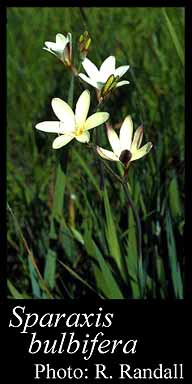- Reference
- K.D.Koenig & Sims, Ann.Bot. 1:225 (1804)
- Conservation Code
- Not threatened
- Naturalised Status
- Alien to Western Australia
- Name Status
- Current
Cormous, perennial, herb, to 0.7 m high. Fl. white-cream-yellow-purple, Sep to Oct. Brown clay loam,grey-white sandy clay, gravel, granite, limestone. Flood plains, valley slopes, along drains, roadsides.

Distribution
- IBRA Regions
- Avon Wheatbelt, Jarrah Forest, Swan Coastal Plain, Warren.
- IBRA Subregions
- Katanning, Northern Jarrah Forest, Perth, Southern Jarrah Forest, Warren.
- IMCRA Regions
- Leeuwin-Naturaliste.
- Local Government Areas (LGAs)
- Albany, Augusta Margaret River, Bridgetown-Greenbushes, Busselton, Canning, Capel, Chittering, Cranbrook, Dardanup, Donnybrook-Balingup, Gingin, Gosnells, Kalamunda, Katanning, Manjimup, Mundaring, Perth, Plantagenet, Serpentine-Jarrahdale, Stirling, Swan, Wanneroo, Waroona, York.
Management Notes (for the Swan NRM Region)
General Biology. Growth form. Geophyte. Life form. Annually renewed corm. Reproduction. Primarily seed, occasionally offsets and cormels on stems. Dispersal. Water, soil. Time to first flowering. 2-3 years. Seedbank persistence. Less than one year. Fire response. Generally survives fire.
Additional information. Origin. South Africa.
Suggested method of management and control. Spot spray metsulfuron methyl 0.2 g/15 L + Pulse® or 2.5-5 g/ha + Pulse® . Apply just on flowering at corm exhaustion. Read the manufacturers' labels and material safety data sheets before using herbicides. For further information consult the Australian Pesticides and Veterinary Medicines Authority to determine the status of permits for your situation or state.
Management Calendar
| Calendar Type | Jan | Feb | Mar | Apr | May | Jun | Jul | Aug | Sep | Oct | Nov | Dec | Comments |
|---|---|---|---|---|---|---|---|---|---|---|---|---|---|
| Dormant | Y | Y | Y | Y | Y | ||||||||
| Active Growth | Y | Y | Y | Y | Y | Y | Y | ||||||
| Flowering | Y | Y | |||||||||||
| Germination | Y | Y | Y | Y | Y | ||||||||
| Optimum Treatment | Y |
Legend: Y = Yes, regularly, O = Occasionally, U = Uncertain, referred by others but not confirmed.
References
- Brown, K. & Brooks, K. (2002) Bushland Weeds: A Practical Guide to their Management. Environmental Weeds Action Network, Greenwood.
- Brown, K. & Brooks, K. (2003) Sparaxis bulbifera (Iridaceae) invading a clay based wetland on the Swan Coastal Plain - control methods and observations on the reproductive biology. Plant Protection Quarterly, 18 (1): 26-30.
- Brown, K. & Paczkowska, G. (2008) Seed biology of two invasive South African geophytes and implications for natural area management. Ecological Management & Restoration, 9 (3): 232-234.
- Hussey, B.M.J., Keighery, G.J., Dodd, J., Lloyd, S.G. & Cousens, R.D. (2007) Western Weeds. A guide to the weeds of Western Australia. 2nd Edition. The Plant Protection Society of Western Australia, Victoria Park.
- Manning, J., Goldblatt, P. & Snijman, D. (2002) The color encyclopedia of Cape bulbs. Timber Press, Portland, USA.
- Moore, C.B. & Moore, J.H. (2002) Herbiguide, the pesticide expert on a disk. Herbiguide, PO Box 44 Albany, Western Australia, 6330.